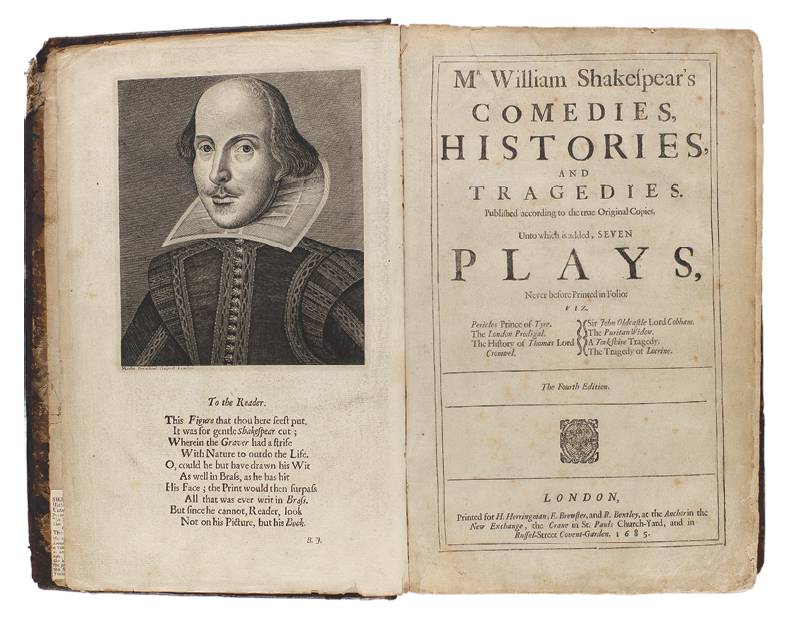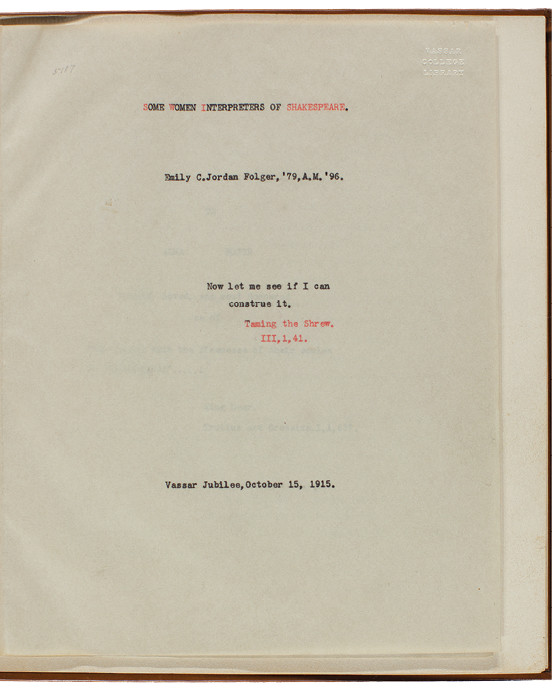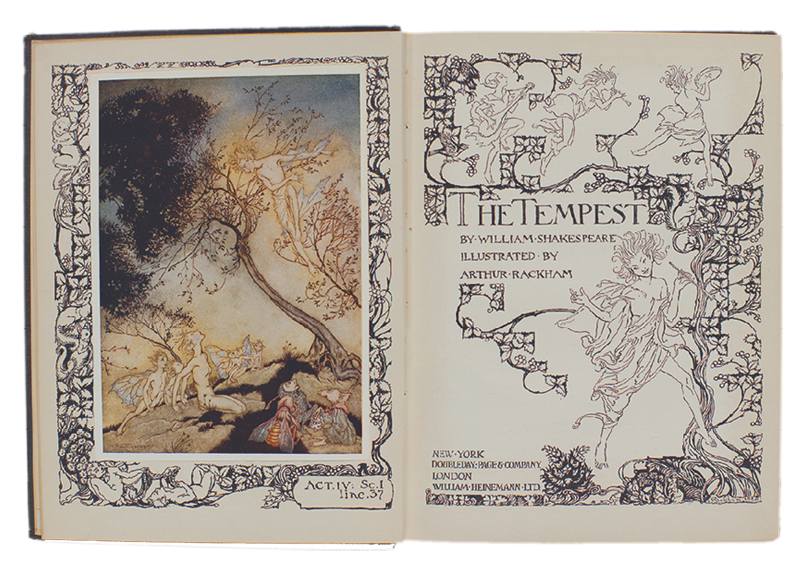Shakespeare at Vassar
Shakespeare in Special Collections
by Ronald Patkus
Associate Director of the Libraries for Special Collections
One of the strengths of the rare book collection at Vassar is English literature. Users can access titles relating to many of the key figures in the literary canon, including, of course, William Shakespeare. A search of the Library’s online catalogue yields over a hundred books by the Bard, and a similar number of books about him. The bulk of these items are housed in the Grille Collection, a general grouping of rare and valuable books. Though the extent of the holdings cannot compete with the large research libraries in the United States and abroad, they are nevertheless impressive, and there are many notable works in our collection. What is more, many of these works have interesting histories, and have come to the college through gifts, bequests, and purchases. Together the Shakespeare books form an important resource for students, faculty, alumnae/i, administrators, and outside scholars. Some highlights are noted below.
The first printings of Shakespeare’s plays appeared during his lifetime as square-shaped “quartos;” these are quite rare, and Vassar holds only facsimiles, in the Main Library. The Special Collections Library does house, however, significant examples of the seventeenth century folios, large format books which collected together in one volume the works of Shakespeare.1 The first item to note is an original fragment of the so-called first folio, the first collection of his plays, which appeared in 1623. The fragment includes the pages of The Merry Wives of Windsor. Of course facsimiles of the full first folio, printed in the nineteenth and twentieth centuries, are also available, in the Main Library and Special Collections. Amazingly, Vassar also possesses full original copies of the second, third, and fourth folios, published respectively in 1632, 1664, and 1685. The fourth folio came first, in 1942, and was donated by Mary Crapo Hyde ’34, “in recognition of the continuing significance of the work in play-writing and play production of the Experimental Theatre of Vassar College under the direction of Hallie Flanagan Davis.” (Figure 4) Hyde, later the Viscountess Eccles, would become known for her scholarship and collecting, especially of Samuel Johnson and eighteenth century literature, but as noted in her obituary in The Guardian, she grew up reading Shakespeare and writing plays. Patricia L. Stewart ’42 donated the second folio in 1944. This copy is especially interesting for its contemporary annotations and corrections. The third folio came to Vassar in the 1990s through the bequest of Ruth Sturm ’32. It’s an untrimmed copy in old calf, with two bookplates, including one of Ruth’s father Ernest, a lawyer and collector from New York. Since the four folios differ from one another in various ways (number of plays, changes in the texts, presence of paratexts, etc.), they provide crucial documentation of the early development of the Shakespearean canon.

In the eighteenth century, the study of the corpus of works intensified, and editors looked more closely at the texts of Shakespeare.2 Many multi-volume editions appeared, in formats smaller than the folios, and Vassar holds most of them. We have, for example, Nicholas Rowe’s seven-volume The Works of Mr. William Shakespear, which appeared in 1709, and is noted for being the first work to feature illustrations of scenes in the plays, and a biography of the playwright. We also hold books written and edited by Lewis Theobald, who has been called “the first Shakespeare scholar.”3 Among them is a1740 edition of The Works of Shakespeare. In 1765 Samuel Johnson put out The Plays of William Shakespeare, with a famous preface, and explanatory notes throughout. Another editor, George Steevens, wrote or edited several books about Shakespeare; including Twenty of the Plays of William Shakespeare, Being the Whole Number Printed in Quarto during his Life-time (1766). Some eighteenth century editions featured comments and notes of multiple editors, and were quite popular. Vassar holds, for example, the third edition of The Plays of William Shakespeare (1785), which is comprised of ten volumes, and features notes of Johnson and Steevens, and corrections by others. Vassar also owns multiple printings of Shakespeare’s works edited by Edmond Malone, who had collaborated with Steevens, but eventually produced his own editions.4
In the eighteenth and nineteenth centuries, a number of important illustrated works relating to Shakespeare appeared, and Vassar has key examples.5 Special attention should be given to the work of John and Josiah Boydell.6 John Boydell in 1789 opened a Shakespeare Gallery in London, which included paintings of scenes from Shakespeare by artists like Robert Smirke, Henry Fuseli, and James Northcote. He published two printed works based on the paintings. The first was a nine-volume illustrated edition of Shakespeare, which had been edited by George Steevens, who died in 1800; it appeared in 1802, under the title The Dramatic Works of Shakespeare. Then, in 1803, a large two-volume elephant folio of prints was published, titled A Collection of Prints, from Pictures Painted for the Purpose of Illustrating the Dramatic Works of Shakspeare, by the Artists of Great-Britain. Vassar is also pleased to house The American Edition of Boydell’s Illustrations of the Dramatic Works of Shakespeare, by the Most Eminent Artists of Great Britain, published in New York in1852. This two-volume work features 96 plates (produced from the London originals) and explanatory texts. In addition, Vassar owns The Shakespeare Gallery…, printed in 1792 and featuring illustrations by Henry Singleton and Robert Smirke, engraved by Charles Taylor and William Nutter. Vassar’s copy is bound in a remarkable Cosway binding, with six vignettes on the front and back covers.
Besides works consisting primarily of illustrations, there are many other books in Special Collections from this period and later that are about Shakespeare. They date as early as 1693, when a work by Thomas Rymer—the Historiographer Royal of England—appeared, titled
A Short View of Tragedy: it’s Original, Excellency, and Corruption: With Some Reflections on Shakespear, and other Practitioners for the Stage. Books from the eighteenth century include Shakespeare Restored, by Lewis Theobald, and Shakespeare Illustrated, by Charlotte Lennox, an author and friend of Samuel Johnson. From the turn of the nineteenth century Vassar owns books by William Henry Ireland, the famed forger of Shakespeare documents; they testify to an intriguing chapter in Shakespeare studies. Around mid-century, lectures, notes, and prefaces on Shakespeare by major literary figures like Samuel Taylor Coleridge, Ralph Waldo Emerson, and Nathaniel Hawthorne were published; Special Collections has copies of these and other late nineteenth century works on Shakespeare. Vassar also holds books on Shakespeare by twentieth century writers, such as Robert Bridges, and Wyndham Lewis.
Some of the books in Special Collections from the nineteenth and early twentieth centuries reveal an interest in Shakespeare on the part of people at the college. One of the earliest is a ten-volume set once owned by Matthew Vassar: the 1823 New York printing of The Dramatic Works of Shakespeare. The founder’s name is stamped on the half titles, and some plays have early penciled notes, almost certainly by Vassar himself. Mary Cowden Clarke’s The Complete Concordance to Shakspere is a reference work published in 1860; it’s noted as being one of the books used at Vassar from 1865-69, and we can assume early students leafed through its pages. There are also a few Shakespeare titles in the Faculty Collection, composed of books written or edited by people who taught at Vassar. These include Ten Plays of Shakespeare, edited by Henry Noble MacCracken, Tucker Brooke, and William Cunliffe, and The Winter’s Tale, edited by Laura J. Wylie.

Surely the most famous early alumna of the college with an interest in Shakespeare was Emily Jordan.7 A graduate of the Class of 1879, she married Henry Clay Folger in 1885; in the course of their lives together, they created the world’s greatest collection of Shakespearean works. Emily earned a master’s degree from Vassar in 1896, writing her thesis on “The True Text of Shakespeare.” Her advisor was Horace Howard Furness, a noted scholar who produced a variorum edition of Shakespeare. His wife, Helen Kate, produced A Concordance to Shakespeare’s Poems. The collection of books and other items created by the Folgers formed the basis of the Folger Shakespeare Library, opened in Washington, D.C. in 1932, in the midst of the Great Depression and two years after Henry died. Though the bulk of the Folger collection stayed in Washington, Emily during her life also donated several key items to her alma mater; they include “Some Women Interpreters of Shakespeare,” the text of a lecture she gave at the college in 1915, on the occasion of Vassar’s fiftieth anniversary.8 (Figure 5) This essay is accompanied by a number of letters, photographs, and manuscripts written by prominent women of the day who shared a love of Shakespeare, scholars and actresses. Emily also gave to the college the manuscript of Helen Kate Furness’ concordance to Shakespeare’s poetry. A “Furness Fund” was established for the Library, and works of Shakespeare were acquired with it.
In the late nineteenth and early twentieth centuries, a great many English and American publishers issued private and fine press editions of Shakespeare, and Vassar is fortunate to have many of them, thanks especially to donors such as Mabel Rossbach, Rebecca Lowrie ’13, and more recently, Charlotte Jones, and the Vassar Club U.K. These books are noteworthy for their aesthetic appeal; they often feature elements such as handmade paper, interesting typographic designs, illustrations by renowned artists, and decorated bindings. The earliest example is a copy of The Poems of William Shakespeare, printed by William Morris’s Kelmscott Press in 1893. We also have one of the twenty-six lettered copies of The Comedies of William Shakespeare, published by Harper & Brothers in 1900, and illustrated by Edwin A. Abbey. Other turn-of-the-century publications in Special Collections include the so-called Vale Shakespeare, a thirty-nine volume set put out by the Vale Press between 1900 and 1903, and three tragedies printed by the Doves Press: Hamlet, Anthony and Cleopatra, and Julius Caesar. The collection has six books printed by the Shakespeare Head Press, as well as The Works of Shakespeare, published by the Nonesuch Press from 1929-1933, with illustrations by artists like Eric Gill. Among the books by American private presses in the collection are works by the Roycroft Press, the Blue Sky Press, the Overbrook Press, and the Peter Pauper Press. The Poems of William Shakespeare, printed by the Overbrook Press in 1939, is a highlight: it’s a large folio, issued in a slipcase, with a morocco binding and decorative initials by Bruce Rogers. The Library also holds Shakespeare titles published by the Limited Editions Club, including all thirty-seven volumes of The Comedies, Histories & Tragedies of William Shakespeare, designed by Bruce Rogers, the famous American type and book designer.
During this same time period, a number of Shakespeare-related books were produced for children.9 Some of Vassar’s copies are from the general Grille Collection, but many are located in the Bechtel Children’s Book Collection, formed by Louise Seaman Bechtel ’15. The tradition of adapting the plays for a younger audience has a long history, and can be traced back at least as far as Charles and Mary Lamb, who in 1807 issued Tales from Shakespear: Designed for the Use of Young Persons. This two-volume work presented twenty tales, accompanied by engravings by William Blake, based on designs of William Mulready. Throughout the nineteenth and twentieth centuries, Tales was continually re-printed, with illustrations by different artists, including Arthur Rackham (Vassar holds a 1909 American edition). Rackham illustrated other Shakespeare books aimed at children that are in Special Collections: A Midsummer Night’s Dream (1908), and The Tempest (1926)(Figure 6). One of the best-known English writers of fairy tales at the turn of the century was Edith Nesbit; she wrote adaptations of Shakespeare, and The Children’s Shakespeare (189-) and Twenty Beautiful Stories from Shakespeare (1907) are in Special Collections. Other examples of books for children from the mid-twentieth century include Anne Terry White’s Will Shakespeare and the Globe Theater (1955) and Marchette Chute’s Stories from Shakespeare (1956).

Many of the other twentieth century books relating to Shakespeare actually come from the library of Elizabeth Bishop, ’34. Special Collections houses a substantial portion of the poet’s own books, as does Harvard University. Among the Vassar holdings, almost twenty titles are either by or about Shakespeare. This is a substantial number, and it tells us something about the poet’s reading habits, or at least something about the books that interested her. Dating from the middle of the twentieth century, none of these books are expensive or finely printed editions, but instead are scholarly or reading editions. Bishop had several editions of the works of Shakespeare in her library. The largest was the so-called “Arden Shakespeare,” published between 1946 and the early 1980s by Methuen, in both hardcover and paperback. Various editors were responsible for the individual titles. Many of Bishop’s copies retain the original dust jackets, and some have handwritten autographs or inscriptions by her. Bishop’s library also includes a few books about Shakespeare, such as Life in Shakespeare’s England (1954), Shakespearean Tragedy (1955), and Shakespeare’s Imagery (1958).
This essay has touched on a few examples of the volumes in Special Collections that relate to William Shakespeare, but they could not be described in detail, due to a lack of space. Moreover, there are many other volumes that deserve attention. Still, I hope I’ve been able to suggest some of the areas where we hold real treasures at Vassar, and that in the future, students, faculty, graduates, and others, will be inspired to examine some of our holdings and delve further into this important area of study.
NOTES
1 In recent years several books on the first folio have been published. See Anthony James West, The Shakespeare First Folio: the History of the Book (Oxford ; New York : Oxford University Press, 2001-2005); Paul Collins, The Book of William: How Shakespeare’s First Folio Conquered the World (New York : Bloomsbury, 2009); and Emma Smith, The Making of Shakespeare’s First Folio (Oxford : Bodleian Library, University of Oxford, 2015).
2 See Colin Franklin, Shakespeare Domesticated: the Eighteenth Century Editions (Aldershot, Hants, England: Scholar Press; Brookfield, VT: Gower Publishing Co., 1991.
3 F. E. A Halliday, Shakespeare Companion 1564–1964.(Baltimore, Penguin,1964)., p. 148.
4 Peter Martin, Edmond Malone, Shakespearean Scholar: A Literary Biography. Cambridge University Press.
5 Stuart Sillars, The Illustrated Shakespeare, 1709-1875 (Cambridge: Cambridge University Press, 2008).
6 See The Boydell Shakespeare Gallery. Eds. Walter Pape and Frederick Burwick. Bottrop (Essen: Verlag Peter Pomp, 1996). For the background to the printing of the books, see Rosie Dias, Exhibiting Englishness: John Boydell’s Shakespeare Gallery and the Formation of a National Aesthetic (New Haven: Yale University Press, 2013).
7 Stephen H. Grant, Collecting Shakespeare: The Story of Henry and Emily Folger (Baltimore: Johns Hopkins University Press, 2014).
8 Elizabeth Sussman Socolow, “Found: Some Women Interpreters of Shakespeare in Vassar’s Folger Collection,” Vassar Quarterly (Spring 1990), 18-21.
9 See, for example, Velma Bourgeois Richmond, Shakespeare as Children’s Literature: Edwardian Retellings in Words and Pictures (Jefferson, N.C. : McFarland & Co., 2008).